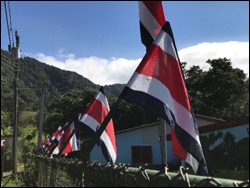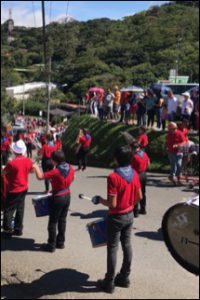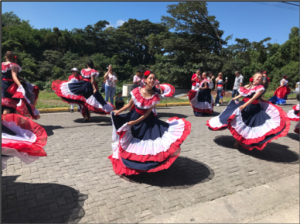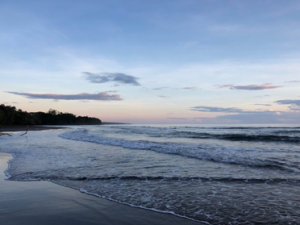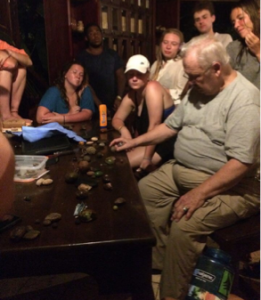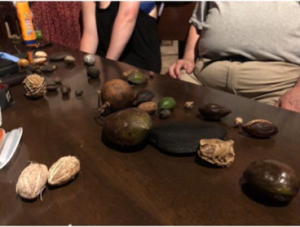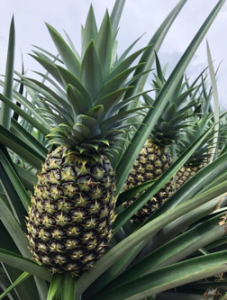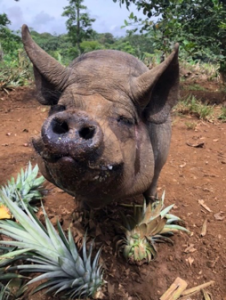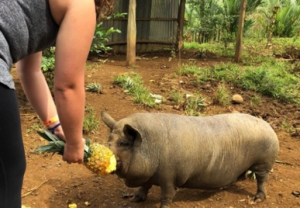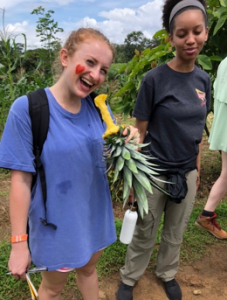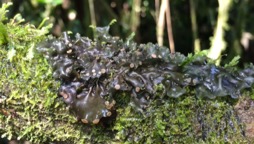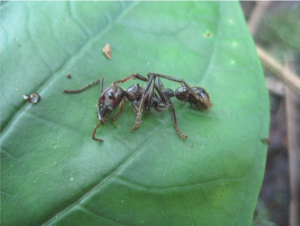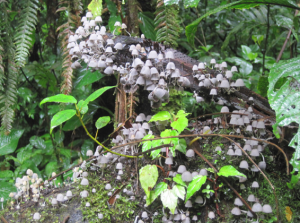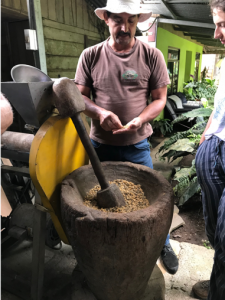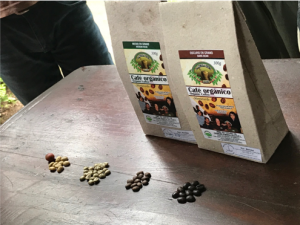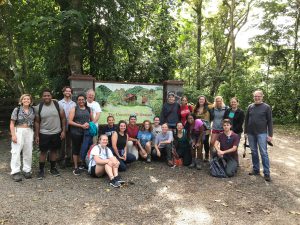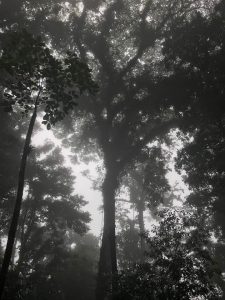
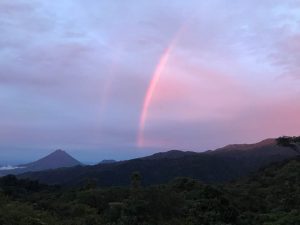
By MG Hall and Lucy Lewis
Our first trip of the semester was to San Gerardo Station, a lodge in the Children’s Eternal Rainforest high up on the Caribbean slope. The night before, we all packed our stuff, which had by this point exploded all over our 4-person bunk rooms, and moved out after breakfast that morning. Once we were finally crammed into the two buses, we headed down the mountain. After a 30-minute ride through twists and turns that took us all the way up the mountain and into the literal clouds, we arrived at the trail head. As soon as we got out of the bus, it was clear that we were in the cloud forest; everything was enveloped in a white fog. Even though the distance wasn’t very far from San Luis, the forest looked completely different. It was much more lush and appeared to have much greater plant diversity. One of the first things that was pointed out to us was the fern trees, which most of us had never seen before. Their tops looked like fern umbrellas.
The hike down was long but all downhill. We had a naturalist, Elliot, with us to point out interesting things along the way. For example, he showed us Tiger Beetles that impersonate ants to trick predators. We saw a number of interesting insects (this whole country seems to be full of beautiful and fascinating insects), including a huge, black millipede! We watched it as it walked, and it was interesting to see how its legs moved slowly and in segments.
An hour and a half later we were at the base choosing bunks and claiming hammocks, completely unaware of the backdrop surrounding us because of the thick clouds that had rolled in, as we would learn they do every afternoon. After a fabulous lunch, the clouds had cleared, and we saw that we had a spectacular view of the Arenal lake and volcano! We could also see a couple of long waterfalls in the mountains in the distance. This isn’t a food blog, but I would be amiss to leave out how phenomenal the food at San Gerardo was every meal; that night our dinner exceeded our expectations with homemade tortilla chips, a mystery soup, and white rice. I’ve never been so happy to be bean-free.
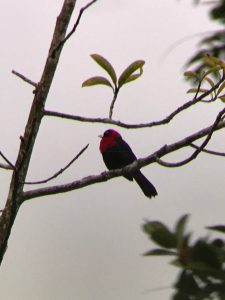
Every day we had the opportunity to go birdwatching in the morning, go on night hikes and go on hikes in the morning. Elliot left us on day two, but once we recovered from that loss, we embraced our new naturalist, Michael, and I for one hung on every word he said since he was a walking eco-dictionary. He told us about the differences in the cloud forest versus the rainforest; for example, water is held most in moss on the bark of trees and can be collected from there and used.
We saw more interesting things than can possibly be recorded in this blog. When I went birdwatching, we saw two types of guans, two types of hummingbirds, a squirrel cuckoo and adorable tufted flycatchers. Other groups s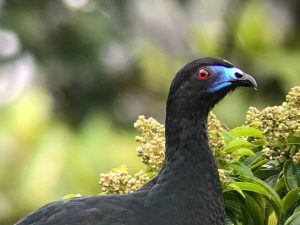 aw parrots and toucanets. On my night hikes, we saw red eyed tree frogs, which are endemic to the area, other types of frogs, a pit viper, all kinds of interesting insects, and my favorite, the bioluminescent beetle larvae. Another group saw a fruit bat and a special kind of frog called the glass frog, which has a translucent body and organs that are visible from the outside. A few highlights from morning and afternoon hikes were holding a huge beetle, little red fruits that smelled just like lemon drops, large, hanging nests of the Montezuma bird, leaves that had been used as temporary homes by tent bats, army ants carrying their eggs, many wild orchids, and puma tracks.
aw parrots and toucanets. On my night hikes, we saw red eyed tree frogs, which are endemic to the area, other types of frogs, a pit viper, all kinds of interesting insects, and my favorite, the bioluminescent beetle larvae. Another group saw a fruit bat and a special kind of frog called the glass frog, which has a translucent body and organs that are visible from the outside. A few highlights from morning and afternoon hikes were holding a huge beetle, little red fruits that smelled just like lemon drops, large, hanging nests of the Montezuma bird, leaves that had been used as temporary homes by tent bats, army ants carrying their eggs, many wild orchids, and puma tracks.
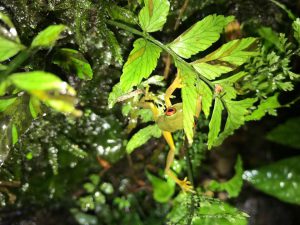
On our third night, Giovani, the manager of the house, told us the story of the land in San Gerardo. He talked for about an hour with Michael translating, but the semi-abridged version is this: Giovani’s grandfather claimed the land in ’53 and with a machete cleared a patch to live in. When I say live in I use the term lightly, as the hut was basically a Naked-and-Afraid-esque lean-to to keep the rain out. According to Giovani’s father, they worked on building up the place and turning some into farm land, but that came to an end in 1973 when the government uprooted it. Their intention was to build a dam near Arenal volcano, about 30 miles from what is now the house, and the government wanted to keep an uninhabited forest around to ensure water quality was up to standard. They asked the whole community to leave in exchange for a fair sum of money. Reluctantly, the 14 families moved into the main town of Santa Elena and waited for a pay off that never came. In 1977, four years past the supposed payment date, farmers decided it was their right to move back to San Gerardo, and so they did. Giovani was 2 at 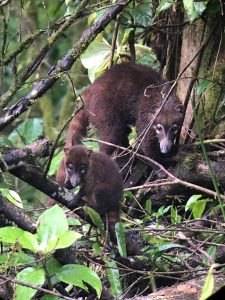 the time and fondly recalled his childhood working with his dad on normal toddler jobs like sawing wood and building their family home. He smiled as he told us about the communal fiestas they would have with the families in “town”. I use quotations because if you could see this place you wouldn’t likely think “community” since the closest mark of civilization to the house is an empty pasture half a mile away, barely 15 feet out of luscious cloud forest. Giovani and his friends have ATVs to get around on nowadays, which I can only imagine become mildly annoying since it rains every single day for a minimum of 2 hours. After everyone moved back, around 1986 the forest, and therefore the farms, were in danger of being repossessed by the government when they realized there were in fact people living on the land they thought they had bought, but this time it ended differently. Somehow, not quite clear on the how since my Spanish is subpar at best, a group of school kids in Europe heard about this and raised enough money to buy out the land that is now the reserve in ‘91, hence the name Children’s Eternal Rainforest. The rest is basically history. It gave the place a new feeling, for me at least, knowing how much time and sweat and love had been put into the land. If Costa Rica could teach the world one thing, it should be how to love your land like they do. We only get this one planet, and if we all treated in like the Ticos do, we might have it for longer. It was unreal to sit on the porch and watch the clouds roll around and over the massive, and active, Arenal volcano while we wrote in our journals about things I had only seen on Animal Planet and the Discovery Channel. The three miles up and back were absolutely worth the 4 days we got to spend in San Gerardo, which means a lot coming from an out of shape college kid. If you ever get the chance to visit and eat Giovani’s food while you watch giant birds and butterflies fly in front of a pink and purple sky lit volcano, I highly recommend it.
the time and fondly recalled his childhood working with his dad on normal toddler jobs like sawing wood and building their family home. He smiled as he told us about the communal fiestas they would have with the families in “town”. I use quotations because if you could see this place you wouldn’t likely think “community” since the closest mark of civilization to the house is an empty pasture half a mile away, barely 15 feet out of luscious cloud forest. Giovani and his friends have ATVs to get around on nowadays, which I can only imagine become mildly annoying since it rains every single day for a minimum of 2 hours. After everyone moved back, around 1986 the forest, and therefore the farms, were in danger of being repossessed by the government when they realized there were in fact people living on the land they thought they had bought, but this time it ended differently. Somehow, not quite clear on the how since my Spanish is subpar at best, a group of school kids in Europe heard about this and raised enough money to buy out the land that is now the reserve in ‘91, hence the name Children’s Eternal Rainforest. The rest is basically history. It gave the place a new feeling, for me at least, knowing how much time and sweat and love had been put into the land. If Costa Rica could teach the world one thing, it should be how to love your land like they do. We only get this one planet, and if we all treated in like the Ticos do, we might have it for longer. It was unreal to sit on the porch and watch the clouds roll around and over the massive, and active, Arenal volcano while we wrote in our journals about things I had only seen on Animal Planet and the Discovery Channel. The three miles up and back were absolutely worth the 4 days we got to spend in San Gerardo, which means a lot coming from an out of shape college kid. If you ever get the chance to visit and eat Giovani’s food while you watch giant birds and butterflies fly in front of a pink and purple sky lit volcano, I highly recommend it.
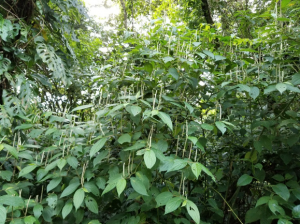
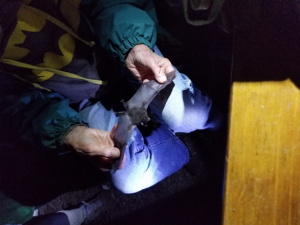 e species form leks, where a group of males gathers to display courtship behavior and attract females.
e species form leks, where a group of males gathers to display courtship behavior and attract females.
